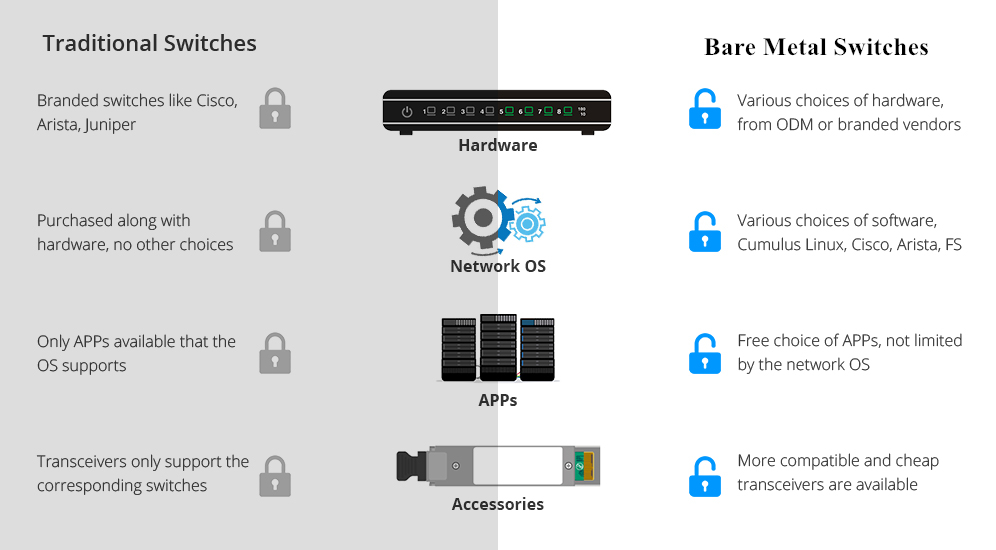Nowadays, the requirement for bandwidth and transmission speed in data centers is increasing strikingly. To meet the demand for it, networking industries are moving toward a new direction. Focuses previously changing from 1G, 10G and 40G are now shifting to 100G. Therefore, 100G is the trend of data center. According to a report by Dell’Oro Group, bare metal switch vendors lost share in the 100G data center switching market in 2018 while traditional vendors, such as H3C, Cisco and Huawei, gained. Do you agree with that? Let’s take a look at what the bare metal switch is and whether it will be popular in 100G data center?
Bare Metal Switch Overview
The bare metal switch is a device that allows for the decoupling of hardware and software on the networking stack. It is from original design manufacturers (ODMs) like Alpha Networks or Accton. These companies design and manufacture products for many mainstream switch vendors. However, warranties offered by ODMs are just hardware based and very basic. Therefore, the bare metal switch has no operating system (OS) and no label. Moreover, bare metal switches come with a boot loader called Open Network Install Environment (ONIE). Based on ONIE, consumers can load open source operating system onto the switch.
Why Bare Metal Switch Will Be Popular in 100G Data Center?
Will bare metal switch be popular in 100G data center? The answer is yes. The following is the comparison of bare metal switch and brand-name switch.
Features – Bare metal switches have multiple choices of OS, including Cumulus Linux, Big Switch Light, Pica8, etc, and their hardware can be bought from different ODMs directly or banded vendors to suit the 100G data center. While brand-name switches should run on vertically integrated OS and hardware that you have no other choice. Hence, with bare metal switches, more flexibility, and options can be enjoyed.
Performance – The brand-name network switch and bare metal switch share a lot of similar performance when used in 100G data center. While the bare metal switch is simpler because of the automated centralized network device management, unified deployment strategies, and fewer configuration errors. What’s more, unlike the brand-name switch, which only supports the corresponding accessories, the bare metal switches are more compatible and multiple accessories are available.
Cost – Consumers can get hardware directly from the ODMs at a discounted rate compared to similar switches from brand-name networking vendors, because there is no OS installed in it. Moreover, with bare metal switches, the network flexibility and scalability have been greatly increased. This will save much cost for users. And then, with good compatibility, you can choose accessories like transceivers from the third-party, which is much cheaper.

Figure 1: Traditional switch vs bare metal switch
Conclusion
The bare metal switch which enables people to purchase hardware and software independently is gaining popularity in 100G data center. It excels propriety or traditional switches in cost and the flexibility. FS employs bare metal switches and Cumulus Linux providing N-series data center switches, including 10GbE switch, 40GbE switch and 100GbE switch. If you have any needs, welcome to visit FS.COM.
Related Articles:
FS N-Series Switches with Cumulus Linux: What Function Do You Expect?
Cumulus Linux: A Powerful ONOS for Network





